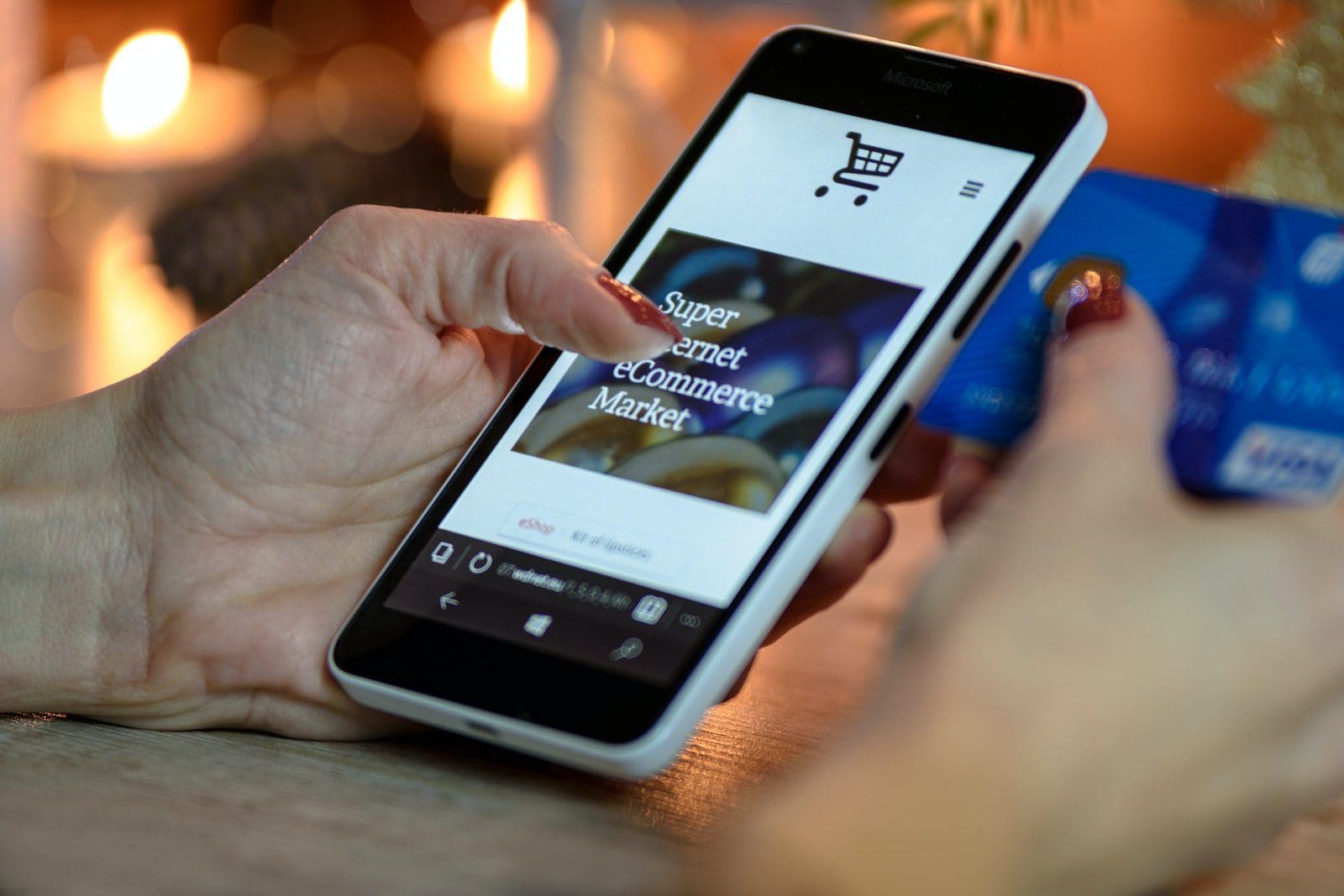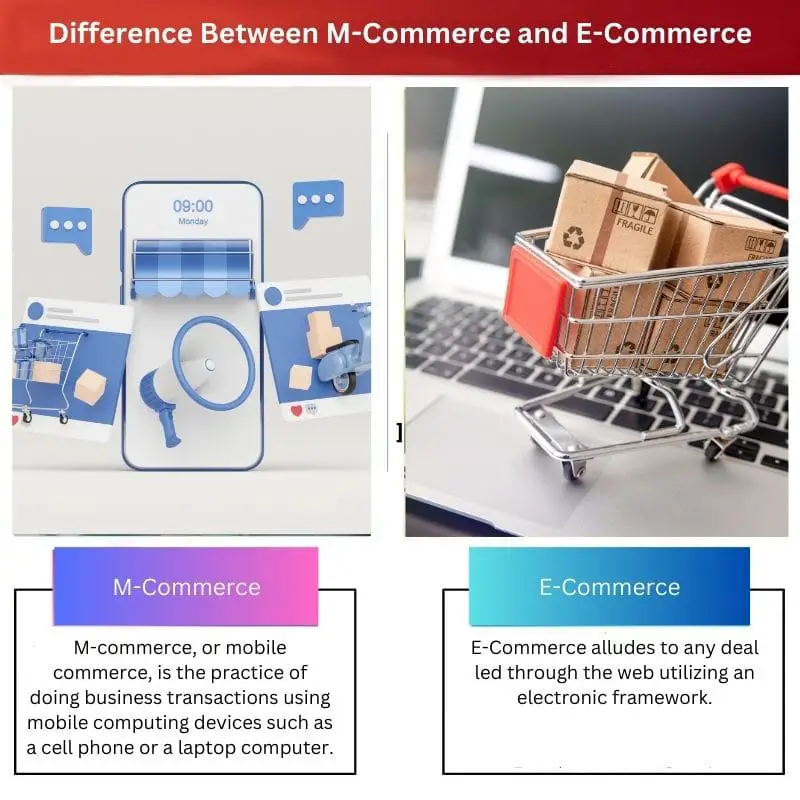The advent of new business models means that customers are no longer forced to stand in line for hours to purchase a single item. On the other hand, traditional commerce is still popular, but mobile commerce (m-commerce) and electronic commerce are now used by everyone (e-commerce).
E-commerce and M-commerce are terms that describe the fields of purchasing, selling, distributing, and servicing various things through commercial transactions on the internet via specialized gadgets.
Key Takeaways
- M-commerce refers to conducting business transactions through mobile devices, while e-commerce involves online transactions.
- M-commerce allows for more immediate and location-based purchases than e-commerce, which is more accessible but less immediate.
- M-commerce requires specialized mobile applications or websites, while e-commerce requires a standard website or online marketplace.
M-Commerce vs E-Commerce
M-commerce means mobile commerce, and it involves carrying out business transactions through mobile computing devices like a mobile phone or tablet. E-commerce stands for electronic commerce, and it means any commercial transaction done through the internet, using laptops and computers.

M-commerce, or Mobile Commerce, refers to cellular or mobile phones with Internet connections for business transactions. As a result, there was no M-commerce before the invention of mobile phones with Internet capabilities; nevertheless.
As a result, marketing has extended even more. The use of mobile phones for commercial transactions and transactions conducted through the Internet has increased dramatically.
Many phones these days have Internet connectivity built-in. M-commerce is growing in popularity as a result of this new technology.
E-Commerce is the practice of conducting commercial transactions through the Internet. Computers and laptops are used to complete business transactions.
Because computers with Internet connectivity have become so widely available, this has grown in popularity. There will be no face-to-face connection between the parties.
It encompasses all those actions that aid in closing the deal, such as transportation, banking, insurance, warehousing, and advertising. For example, there are many different e-business models, such as where a company sells to another company or where a company sells to a customer.
Comparison Table
| Parameters Of Comparison | M-Commerce | E-Commerce |
|---|---|---|
| Definition | M-commerce, or mobile commerce, is the practice of doing business transactions using mobile computing devices such as a cell phone or a laptop computer. | E-Commerce alludes to any deal led through the web utilizing an electronic framework. |
| Developed In | 1990’s | 1970’s |
| Devices | iPad, Mobile, and Tablets | Laptops and Computers |
| Requirement Of Internet | Not mandatory | Yes |
| Reach | Because of its mobility, it is widely used. | Strictly limited, it can only be accessed in locations with both internet and power. |
What is M-Commerce?
In the context of m-commerce or mobile commerce, cell phones, in particular, are used to conduct business. Broadband Search estimates that 55% of internet traffic is now on mobile devices vs 42% on PCs.
The remaining 3% of mobile internet traffic is attributed to tablets (in other words, larger mobile devices).
The requirement for companies to provide an omnichannel experience and make their websites accessible via mobile devices is growing as more customers purchase things online than ever before. Purchases Cycle says mobile devices will account for 68% of online buying in 2020, with m-commerce traffic accounting for 56% of sales.
M-commerce includes a wide range of transactions. Thus businesses have many options for using it in sales and marketing.
In addition to offering mobile payment choices such as Apple Pay, Visa Checkout, and Android Pay, this also entails personalizing the customer experience with tailored content and offering global delivery options.
It’s possible that taking advantage of this route entails making changes to your website’s features to serve better mobile phone users, such as adding more oversized buttons or improving the user experience (UX) on the page. When it comes to optimizing websites, this also means providing clients with a smooth and fluid experience that allows them to explore and make purchases without experiencing any problems or issues.
When working on this, it’s essential to know how your customers use your site so you can come up with new methods to make their shopping experience better when using a smartphone.

What is E-Commerce?
Trade of products and services through a network such as the internet is referred to as e-commerce. A lively city centre or a physical store transformed into a string of zeroes and ones on the world wide web.
According to the company’s estimates, more than 150 million Amazon Prime members will shop at Amazon shops this year.
E-commerce is only one method by which individuals purchase and sell goods in the retail sector. E-commerce is a distribution method for many businesses, but it’s a stand-alone business model with physical storefronts and other income sources.
E-commerce, in any case, enables small and big enterprises to offer their goods on a global scale and attract new clients. Online buying is constantly changing and evolving.
Consumers use a variety of devices to conduct their business, including PCs, smartphones, and tablets. They shop online, use social media, and engage in a variety of dynamic virtual communities.
Here’s a quick look at three popular ways to do business via the internet right now.
A digital storefront on the internet is what you’d call an eCommerce website. A buyer and a seller may do business more quickly because of it.
It’s a place where you may show off your wares and let potential consumers make purchases. Your online business channel’s website serves as the company’s product shelves, sales crew, and cash register.
Businesses may construct their commerce site on a separate domain or develop a branded Amazon store experience for a multi-channel strategy.

Main Differences Between M-Commerce and E-Commerce
- M-commerce is an abbreviation for Mobile Commerce, while E-commerce is an abbreviation for Electronic Commerce.
- M-commerce transactions occur using mobile devices, while E-commerce transactions occur via computers.
- M-commerce is accessible anywhere you go, even if there is no Internet connection. For E-commerce, you must still visit a location with Internet connectivity to view your online transactions.
- M-commerce is very convenient and portable. Unlike with E-commerce, you cannot always bring your PC or laptop with you.
- M-commerce is billed through the caller’s rate, credit deducted from the user’s account, and mobile banking. E-commerce is facilitated by the usage of credit cards swiped by credit card machines.

- https://www.igi-global.com/chapter/present-and-future-of-mobile-commerce/150081
- https://journals.sagepub.com/doi/abs/10.1068/a35104

The need for companies to personalize the customer experience through mobile payment options and tailored content in M-Commerce is crucial. Understanding customer behavior and optimizing websites for mobile users are essential aspects for businesses in this realm.
Understanding the different ways of conducting business through M-Commerce and E-Commerce is vital for businesses to cater to a diverse consumer base. The rise of the mobile internet further emphasizes the importance of mobile-optimized experiences for customers.
The detailed explanation of the main differences between M-Commerce and E-Commerce underscores the need for businesses to have a clear understanding of these fields and adapt their strategies accordingly. This article provides valuable insights into these evolving areas of commerce.
The provision of various examples of digital businesses through E-Commerce was an insightful addition. It highlights the diversity and potential uses of E-Commerce in the current market.
The comparison table is quite enlightening, and indeed, the two are different in significant ways. This highlights the need for businesses to have adaptability and cater to both mobile and laptop users.
This development in commerce is truly revolutionary, especially for businesses aiming to take their sales online. I appreciate the distinction between M-Commerce and E-Commerce, as well as the need for more omnichannel experiences.
The growth of M-Commerce, given the rise of mobile internet traffic, is remarkable. Businesses need to ensure they optimize their websites to provide a seamless experience for mobile users to capitalize on this trend.
E-Commerce’s transformation into a zero and one on the internet is an interesting analogy. It emphasizes the digital shift happening in the retail sector and the need for businesses to adapt to various online platforms for sales.